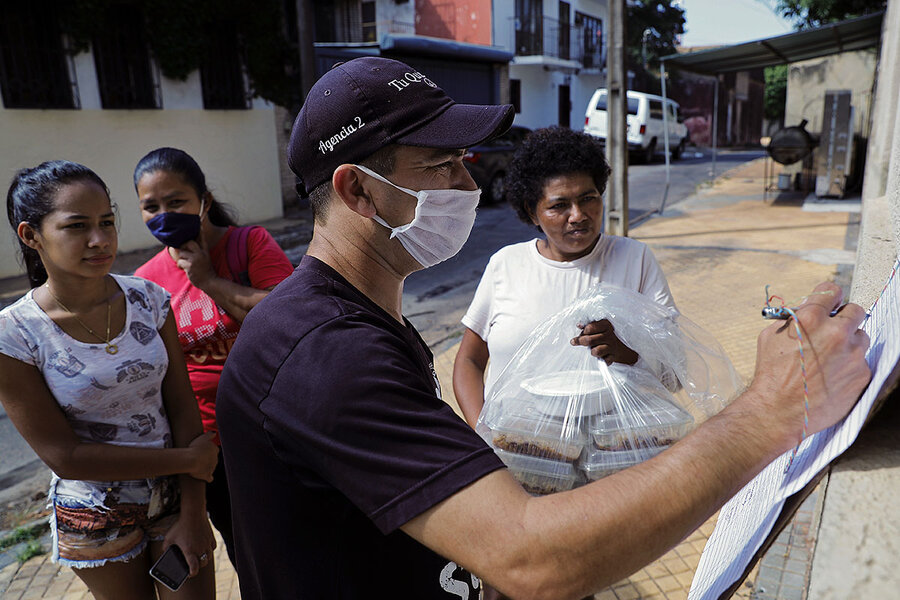No jobs, so what future? Half the world’s workforce on the edge.
| London
The figure is jaw-droppingly large: 1,600,000,000. One-point-six billion.
Even amid the torrent of statistics surrounding the COVID-19 crisis, it stands out. And while it’s received only scant media attention, it matters. A lot. Because it highlights a critical and truly global challenge almost sure to outlast the pandemic itself.
That 1.6 billion is the number of people on the margins of the world economy, from migrant workers to those employed in the gig economy, who are in immediate danger of losing their livelihoods. They make up half the world’s workforce and it is far from certain that their jobs will reappear even when the crisis is over.
Why We Wrote This
Hundreds of millions of people worldwide have lost their jobs as a result of the coronavirus pandemic. But what about the 1.6 billion workers in the “informal sector” – half the global workforce – who didn’t have a steady job to start with?
Hundreds of millions of jobs have been put on hold by coronavirus shutdowns around the world. That’s been especially true in countries already hit by the pandemic. But other areas, like Africa and much of South America, are suffering from the international economic fallout and are likely to face heightened job losses if the pandemic strikes harder there.
In the United States, more than 30 million people, over 15% of the workforce, have applied for unemployment benefits in recent weeks. In Western Europe, joblessness is also increasing. Only government wage-support subsidies have staved off a U.S.-scale spike, by keeping idle or furloughed workers notionally employed. In China, official statistics have reported only a slight uptick in unemployment. But that figure excludes a migrant workforce of nearly 300 million people.
That’s where the 1.6 billion figure comes in. Released last week by the International Labor Organization, it covers the so-called informal economy – whether migrant, agricultural, or shift workers in the developing world, or the gig workers and service-industry staff increasingly predominant in wealthier economies. The ILO found that COVID-19 had left almost all 2 billion of them finding it precariously hard to make ends meet.
The immediate challenge for governments essentially involves budgeting, or printing, more money: for multitrillion-dollar stimulus programs like those in the U.S., or salary-support schemes favored in Europe and elsewhere. And there is every likelihood that the sums needed for such schemes will grow further.
But that may turn out to be the easy part. An even tougher challenge lies ahead.
The best-case scenario envisages a fairly early exit from COVID-19, through a combination of treatment or inoculation advances and a staged reboot of the world economy. It’s a hope shared on all continents, by governments democratic and authoritarian. A number of U.S. states, as well as COVID-affected countries in Europe and Asia, are now tentatively beginning to reopen for business.
But there’s a key question, even in a best-case scenario: How many of the jobs lost to COVID-19 will be lost for good, or at least for a long time after the economic reopenings? That question is particularly acute in the service economy – restaurants, leisure businesses, small retail shops – and for the ILO’s 1.6 billion strugglers in the informal economy worldwide.
Much will depend on the longer-term effects of the blow COVID-19 has dealt to the world economy, through major slowdowns in the world’s two leading economies, the U.S. and China, and huge disruptions to international trade.
Two very different examples: Across Asia, millions work in garment and other factories that have thrived largely on exports to Europe. Many were suddenly made jobless by COVID-19 shutdowns. The question now will be whether, or how quickly, demand for their products will rebound in a post-pandemic world economy.
In Europe itself, Greece has so far confounded predictions by avoiding the kind of mass outbreaks that have claimed tens of thousands of lives in Italy, France, and Britain. But the tourism sector is critical to Greece’s economy, employing a fifth of the workforce. The country can only hope not just that airlines and airports reopen, but that the tourists recover a pre-pandemic appetite for air travel.
Yet beyond the economic imponderables, long-term mass joblessness – possibly on the scale of the Great Depression in the 1930s – could pose major social and political challenges.
Work, especially for those living payday to payday, is essential to economic survival. But it’s also central to people’s identity, their sense of self-definition, even self-worth. The human cost of the Great Depression – a period that, like many of great suffering, also produced great insights and works of art – is perhaps chronicled nowhere as searingly as in the pages of John Steinbeck’s “Grapes of Wrath.”
While work can form a core part of a person’s identity, worklessness can depress and embitter. A more recent example – the political fallout from the 2008 world financial crisis – is a reminder that one result can be a growth in the kind of anger and resentment on which populist strongmen often feed.
The good news, or so organizations like the ILO are emphasizing, is that the employment crisis caused by COVID-19 is not limited to one country or region. Their hope is that, rather than focus only on the domestic imperative of getting each national economy back on its feet, governments will take shared, international action to address the needs of the “1.6 billion” in a post-pandemic world.







